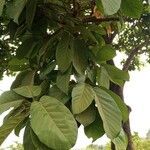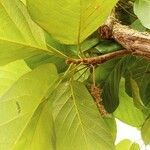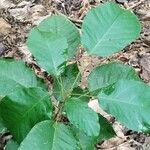Leaves collected towards the ends of the branches; lamina up to 20 × 12 cm., leathery, entire, broadly oblong, obovate-oblong, or ovate-oblong, apex obtuse or abruptly acuminate, base rounded or slightly cordate, penninerved, thinly pubescent or glabrescent above, more or less ferruginously tomentose beneath; petiole up to 5 cm. long.
Female flower: ovary ovoid, tomentose, with a ring of vestigial anthers at its base, on a glabrous gynophore up to 1 mm. long; style c. 1 mm. long, tomentose.
Calyx campanulate, divided to about half-way into 4–6 narrowly oblong lobes which are coherent at their tips, pubescent outside and on the lobes within.
Male flower: stamens numerous, in a capitate globose cluster on a glabrous androphore c. 2 mm. long surrounded by a ring of hairs at its base.
Follicles c. 5 cm. long, ellipsoid with an acute apiculus, ferruginously tomentose outside and inside.
Flowers reddish, in harshly pubescent panicles c. 12 cm. long, clustered at the ends of the branches.
Large tree 15 m. tall or more, with smooth greyish bark and stiff rugose branchlets.
Seeds c. 1·6 × 1·2 cm., oblong-ellipsoid; testa black; aril small and yellow.
Conspicuous with red-purple flowers about Jan.–Feb.
Bole 30–40 ft., sometimes buttressed
Fruit bright red turning brown.
Yielding a coloured gum
Up to 80 ft. high
Grey corky bark
A tree




